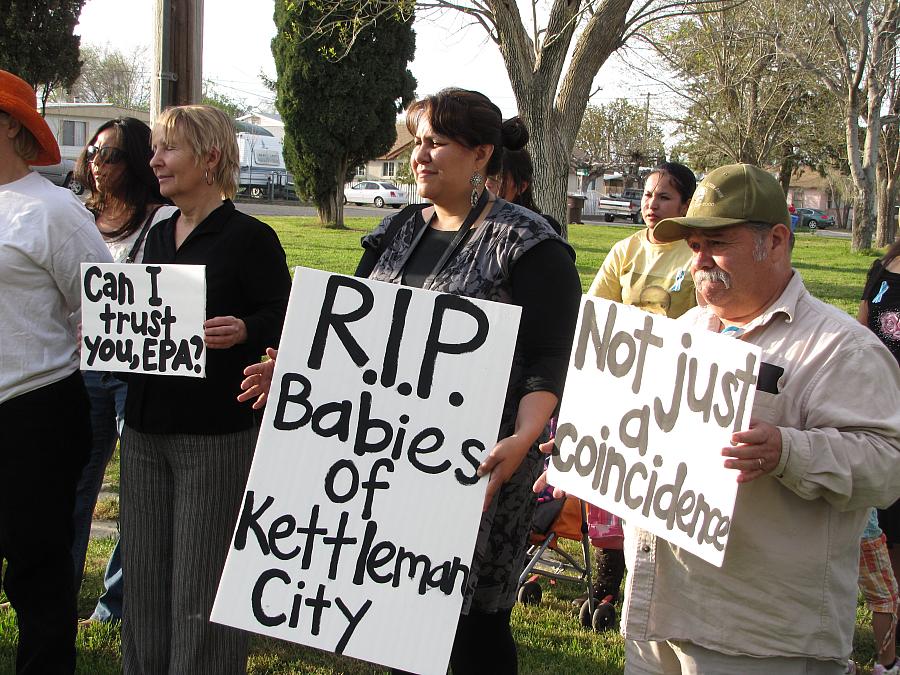Reporters balance personal stories, science when reporting on environmental health hazards

Reporters Ruxandra Guidi and Erica Peterson live about 2,000 miles apart. But when they embarked on in-depth stories on environmental justices issues in their communities, they faced very similar challenges.
Guidi, a reporter for Southern California Public Radio, analyzed where our trash goes, as part of her California Endowment Health Journalism Fellowship. Her reporting for the three-part series led her to the Eastern Coachella Valley, where she visited the Lawson Dump, “home to 40 acres of garbage that rises two stories high,” according to her report. The U.S. EPA shut down the dump six years ago, but it’s still smoldering.
Guidi spoke with community health worker Eduardo Guevara, who questioned whether the dump posed health risks to the residents of a nearby trailer park. Most of the 1,500 residents are farmworkers or immigrants.
“There are many people out here with respiratory problems,” Guevara said. “Maybe researchers can’t link it directly to the dumps, but it’s a big coincidence for a community that has been living next to a burning open-air dump for years, don’t you think?”
Peterson, a reporter for Louisville Public Radio, investigated air pollution and its health effects on residents of Louisville’s Rubbertown neighborhood, through a National Health Journalism Fellowship. As part of her month-long series, she interviewed Trish Lee, who can’t escape the smell of the nearby chemical plants, rail yards and oil refineries.
“Sometimes it burns,” Lee said. “Like you can go outside, sometimes at night, and your eyes actually burn.”
I reached out to Guidi and Peterson via e-mail to ask about their experiences reporting these important, but complex, environmental stories. I’ve investigated similar issues in California, so I could relate to the reporters' struggle to balance community residents’ experiences with scientific data, or the lack of it.
In one of her reports, Guidi included terrifying descriptions of local landfills and residents’ concerns about them. But she was also careful to point out that there’s no scientific evidence linking facilities to community health problems.
“Reporting these stories was a major lesson for me on how difficult it can be to navigate anecdotal evidence, limited scientific findings, and misinformation,” Guidi wrote in her email to me. To fill those gaps, she said, she tried to get her hands on any evidence or studies on the impacts of trash, especially on communities of color, and farmworker and immigrant communities.
Peterson echoed those comments. She reported on the community’s concerns about incidences of cancer in Rubbertown. But she made it clear that it’s impossible to determine what role - if any - pollution plays in elevated cancer rates.
“This was a big challenge, mostly because science still isn’t at the point where it can say with certainty that a certain chemical is responsible for a certain type of cancer,” she wrote. “So, the only story I could honestly report was one that reflected that uncertainty.”
“I didn’t want to discount the community’s concerns about cancer, because there’s definitely a strong possibility that the toxic chemicals they’ve been exposed to have played a role in recurring health problems, but it would have been irresponsible to base the story solely on first-person accounts and unverifiable science.”
Despite these challenges, both Guidi and Peterson appear to have made concerted efforts to elevate the voices of the community members burdened by pollution.
Guidi said it was daunting to sort through little existing data, and engage and challenge public officials who, she wrote, “are known for ignoring the community’s health and environmental concerns.”
“Environmental injustices can thrive in such conditions, where there is little research and accountability,” she wrote. “This made it all the more important for me to try to do my best with the stories, given the limitations, to get to understand the root of the communities’ concerns, and find new ways to frame the debate.”
Peterson reported on Louisville’s revolutionary air toxics program, which has reduced the levels of dangerous chemicals in the air. But, she explained, residents still have concerns about their health.
“What I tried to convey in the story is that the progress the city has made is important, but so is the fact that people near Rubbertown still have concerns and still are being negatively affected by their proximity to the industry,” she wrote.
In an earlier post, I asked Mark Grossi, the Fresno Bee’s veteran environment reporter, for tips on covering environmental justice issues. I asked Peterson and Guidi for tips, too.
“These are important stories to tell, but with any health or science reporting, it’s important to report uncertainty, if that’s the case,” Peterson said.
Guidi recommended beginning the reporting process by digging for data. If it doesn’t exist, she said, “I would partner up or collaborate with a local health/environmental organization that is looking at the issues; I would try to find local researchers, doctors, nurses, or promotoras who can guide you on the history of the community’s problem.”
“In the process of reporting the story, I would ask myself: What’s driving me to report this story? How can my reporting promote debate of the environmental justice issues; what makes it ‘universal;’ and how can I frame my story to get a response from readers and officials alike?” she wrote.
Photo Credit: Rebecca Plevin

